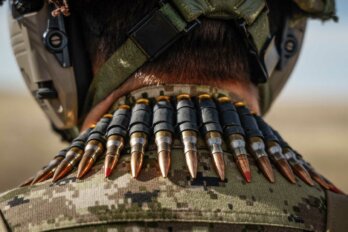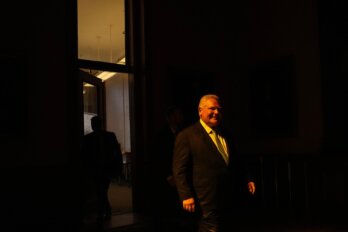Omar leaned against the escalator railing and looked down into the depths of the shopping mall. “Since we became thieves, the moon came out,” he said glumly. The Persian expression means something like We missed the boat. We’d just visited the travel agencies on the lower floor of the Gulbahar Center, in Kabul.
It was 2016, and Omar’s family was leaving Afghanistan. Four of his siblings were already in Europe, and his mother and sister were getting ready to escape with smugglers. Afghans were losing hope in their country’s future. The civil war had intensified, Kabul was being torn apart by bombs, and American soldiers were on their way out of the country. Now, Omar wanted to leave too.
I’d known him since I started reporting in Afghanistan, seven years earlier. He’d always dreamed of living in the West, but those dreams were dashed when he was denied a visa to the United States. He was left with the same prospect as his mother and sister: taking the smugglers’ road to Europe, a long and dangerous journey across the mountains and the sea.
Six months ago, when Europe’s borders were still open, the travel agencies had been packed with smugglers, some offering all-inclusive trips from Kabul to Germany, guaranteed or your money back. Now, we’d been told that the farthest you could go from here was Istanbul.
Imagine the cities of the world connected by a network of paths that measure not physical distance but danger: the risk of getting arrested, stuck in transit, scammed, kidnapped, or killed. For the underground traveller, the shortest distance between two points is rarely a straight line; it may even be a flight halfway around the world to transfer in an airport with corrupt officials. The space between two people clasping hands through a fence can be wider than a desert. For each line, there is a price. More money means less risk, and migrants take the shortest path they can afford. Only a fraction of the network is visible to any individual traveller, and the lines shift as borders tighten and people find new ways to cross them. The previous year, some migrants seeking asylum in Europe had discovered a loophole where you could bicycle through the Arctic from Russia to Norway.
For Afghans, the longest, cheapest route into Europe was across the land border with Iran and then over the mountains to Turkey—an exceedingly dangerous journey. The short way was to fly to Istanbul with a visa, as Omar’s parents had done. That had been his plan too, and since demand had dropped now that Europe’s border was closed, he had been able to haggle at one of the agencies for a visa and a flight for $2,500, half of what his mother had paid a few months earlier. The agent had told him that it would take at least two weeks.
Once Omar got the visa, we would fly to Turkey together. From there, it would be up to him how he wanted to get smuggled into Europe. Most likely, we’d take a boat to the Greek islands. I was both nervous and relieved. Now that Omar’s house was empty, we spent our nights there playing cards and watching Turkish soap operas, dubbed and censored. When the news came on, the headlines that summer of 2016 were no longer about people in boats but about the UK voting to leave the European Union, about the Republican Party nominating Donald Trump, and about a truck crushing people on the boardwalk in Nice.
Sometimes, two of Omar’s friends from the neighbourhood would join us. Zakaria was nineteen, a tall and raw-boned basketballer. Born and raised as a refugee in Iran, he was Hazara, a largely Shia ethnic minority that had been historically oppressed by Afghanistan’s Sunni rulers. Hazaras tended to have distinctly central-Asian features, such as high cheekbones and almond eyes. Their faces marked them as Shia for murderous extremists like ISIS in their own country and as Afghan refugees in Iran, where the police were constantly stopping young men like Zakaria. He had gotten so fed up with his precarious status that he’d considered joining the Fatemiyoun, the Afghan militia the Iranian government was recruiting to fight on the side of the Assad regime in Syria. The pay was good and you could win legal residency in Iran for your whole family. But he’d heard too many nightmarish stories about the fighting in Aleppo and how the rebels would pull out your intestines with skewers if they caught you. Instead, he had decided to flee to Europe but had been caught on the Turkish border by the Iranians and deported to Afghanistan, a land he’d never seen before. Now, he was working cleanup on construction sites, getting stoned in the evenings and listening to Rihanna, dreaming of escape.
Omar’s other friend Malik was a tailor who’d grown up in Kabul. He was twenty-one, slender with curly hair, and sat with his shoulders hunched forward, as if trying to take up less space. The previous fall, Malik had borrowed $1,400 (US) from his relatives, just enough to pay a smuggler to take him to Istanbul the hard way, across the deserts of Nimroz and into Iran. It was a harrowing ordeal, he told us. He had walked without water for a whole day, and once he was in Iran, the smugglers had stuffed him into the trunk of a car. After two weeks, he made it to the Turkish border, where the Iranian guards caught him and deported him back to Afghanistan. “I heard that it was dangerous, but I didn’t think it could be that dangerous,” he said. “I thought I was going to die.”
Some part of me was curious to travel that desert road, but I knew Omar didn’t want to take unnecessary risks. It would be dangerous enough getting into Europe from Turkey now that the border had closed.
It was a hot, sunny day, and Omar had his Corolla’s windows down as we inched through traffic. In the blue sky above Kabul, the white surveillance blimp had a clear view for its array of cameras, what is known as wide-area persistent surveillance, technologies like Gorgon Stare and ARGUS-IS. In Afghanistan, we were living in a fishbowl. The US government accumulated the trivia of our lives: every cellphone call and message, each late-night sext, was collected into the MYSTIC program. Perhaps the very hairs on our heads were numbered. That day, the aerostat would have recorded our Corolla amid a sea of Corollas, slowing to walking speed and then to a crawl as we moved into the centre of town. Along the riverbank, half-ruined and half-constructed buildings stood in a jumble of raw concrete and rusted rebar, their tinted glass smeared with kebab soot, the ground-floor shops arranged by genre: phones, gold, pots and pans. Omar parked at Mandawi Bazaar and we got out, entering a covered warren of one-room clothing shops, each with a merchant holding a phone in one hand, a fly swatter in the other. We were shopping for our migrant outfits.
In the Afghan countryside, people wore traditional tunics and pantaloons, and dressing otherwise could attract unwanted attention. Whereas, in downtown Kabul, you saw as many men in jeans or suit jackets. There was a class aspect to it: some young professionals turned their noses up at robe wearers. But rich and poor alike knew that, if you went to Europe, you had to dress like the people there.
Omar and I walked to the cheap part of the bazaar, in the open, by the stench of the riverbank. The garments here came from factories in Bangladesh and Cambodia, wherever wages were lowest, and they were similar to what you would find at bargain retailers like H&M and The Gap, which feed the West’s insatiable demand for fast fashion. But, though the style here followed trends from London and New York, it seemed amplified by distance: neon fleurs-de-lis on pastel checks, superlatives spelled with sparkles, caterpillars of ornamental darning. I examined the tag on a pair of houndstooth cotton pants, printed on elegant, heavy-gauge cardboard:
Ever Since The Ending Of
The Epoch In Which The Grandee Toilette
Prevailed The Convenients
Succinct And Function Modem
Fashion
Tide Have Changed The Visage
Of The Men’s Apparel And Their Life
Signifier had decoupled from signified; knock-offs became forms in themselves. There was a rack of “CK” belts: Cal Kreian and Calwine Klam. We bought floral shirts and distressed jeans and then got back into the Corolla and drove to Bush Bazaar, a sprawl of shops built from recycled shipping containers. These standardized steel boxes were one of the most important logistical innovations of our time: by greatly reducing the labour costs of global trade, they’d given an increasingly cosmopolitan character to consumption. Amazon was unthinkable without them. Bush Bazaar, named for the forty-third US president, had sprung up soon after the 2001 invasion, specializing in objects that fell off military trucks, but had since diversified into imported cosmetics, camping gear, and second-hand clothing whose fabric was often of better quality than the new stuff we’d seen.
In the 1960s, anthropologist Louis Dupree was amused to see Afghans walking around in American surplus uniforms complete with World War II campaign medals. Back then, 95 percent of Americans’ clothing was made in the United States; today, 90 percent comes from abroad. As a result, many garments make a circular journey around the earth. When you donate used clothing to a local charity, it’s typically sold in bulk back to the developing world. We entered one of the container shops that specialized in used T-shirts and browsed through the universal opulence that was America.
There were shirts for softball tournaments and family reunions, for towns where people partied on beaches and towns where they enjoyed colonial history. There were shirts with jacked Christian angels, fast food brands, a “Barack the vote” T-shirt, a National Rifle Association T-shirt, and a shirt that said “Tell your boobs not to stare at my eyes.” There were cuboid stacks of XXL and XXXL shirts in dimensions that did not obtain for any Afghan I’d ever known except for one or two warlords. “In America, the poor are fat and the rich are skinny,” I told Omar, who shook his head in disbelief.
The white noise of English pervades the planet. I had journeyed unembedded into the heart of the Hindu Kush and taken tea with white-bearded elders wearing Playboy Bunny knit caps and Johnnie Walker sweatshirts. On my first visit, in 2008, I spent an evening in a chaikhana in Ghor discussing whether dancing was a sin. My companion explained that, in his written works, Ayatollah Khomeini neither expressly prohibited nor permitted dancing. Halfway through our conversation, I noticed he was wearing a pullover with a caricature of a dandy brandishing a cane, above which it read, unbeknownst to him, “Marlborough Dance Center.”
At Bush Bazaar, I bought a yellow Lucky Charms T-shirt. Omar picked a black one with a Harley under the Stars and Stripes and “land of the free” underneath. Then I selected a thirty-litre backpack. On our way out, we stopped to gawk at a collection of knives in a glass case, everything from pocket knives with tweezers to blackened, spring-loaded switchblades.
“Should we get some?” Omar asked. I looked up from the cabinet. Pretty soon we’d be on our own in some rough places.
“You’ve been in knife fights before, right? How many people have you stabbed, anyway?”
“Many, I don’t know. Ten people or more.” He started counting the scars on his arms and neck. “In Iran, in Pakistan, in Afghanistan . . . . Forget it. I did it to defend myself, because I had to.”
We left unarmed.
Excerpted with permission from The Naked Don’t Fear the Water by Matthieu Aikins © 2022. All rights reserved. Published by HarperCollins Publishers.




